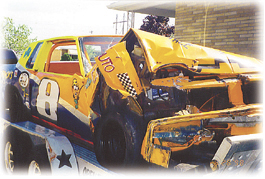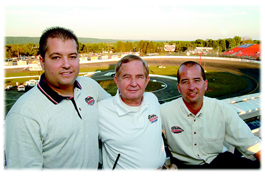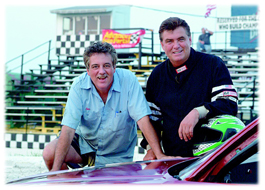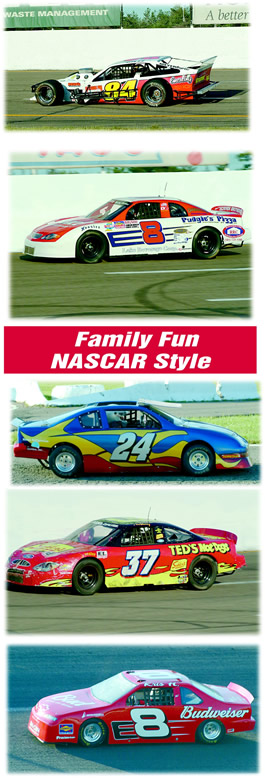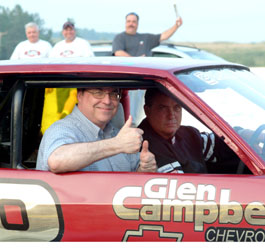

From Lovin’
It
to Livin’ It.
A Need for Speed Shifts Stock Car
Racing Enthusiast Tom Agen’s
Life into High Gear
by Doug Carpenter
Tommy Agen gets around. And around… and around… and around. If that sounds a little racy, well… Tommy’s a racy kind of guy. Car racy, that is. The “Gentlemen, start your engines”/“Take a victory lap” kind that’s the heart and soul of one of the most uniquely American of our sporting pastimes: stock car racing.
You may know the sport best as NASCAR, the National Association for Stock Car Auto Racing. That is, of course, if you know anything about it at all. I say if because, despite its well-supported claim to be the most popular spectator sport in America today, stock car racing is a recreational activity with something of a split personality.
Those who know and love it… and I mean L-O-V-E LOVE it… live it and breathe it with a passion other sports can only dream about. It has become a multi-billion dollar revenue generator that has carved out a major place for itself in the American sports consciousness and, in the process, elevated many of its most successful competitors to superstar status.
Those who haven’t ever watched a stock car race on TV or attended one at the thousands of large and small tracks around the country have probably heard some of their names. High-profile race-winning drivers like Cale Yarborough, Jeff Gordon, Bill Elliott, Dale Earnhardt and Richard Petty.
But you’ve probably never heard of Tom Agen. And that’s too bad. Because drivers like him are really what stock car racing has traditionally been… and continues to be… all about. About doing it for the sheer love of doing it.
Stock Car Racing 101:
The Basics.
Let’s assume you’re one of the un-clued in masses who wouldn’t know a restrictor plate from a dinner plate. [Those of you who already know this stuff are permitted to smile with polite amusement while the rest of us get up to speed.] Stock car races are run largely on concrete- or asphalt-paved oval tracks. Ovals shorter than a mile are called short tracks and unpaved short tracks are called dirt tracks. [I did say these were the basics.]
The most important thing about stock car racing, however, is the cars. And stock cars are just that. Vehicles that look not like the sleek, low-to-the-ground machines that circle the track in races like the famous Indianapolis 500 but like a family sedan you or I might buy off the dealer’s showroom floor.
But even though the Ford Taurus, Chevrolet Monte Carlo or Dodge Intrepid you see running in “stock” races may look like the one in your driveway, on the inside they’re structurally very different. They only have one seat […a dream come true for anyone who hates backseat drivers], no headlights and a gas tank where the trunk should be. So they may look stock, but they’re clearly very different animals… as are the people behind the wheel. Guys like Tom Agen.
Answering the Call
of the Oval Road.
At 54, Tommy Agen is not your typical stock car driver. He’s the first to concede that it’s more of a younger person’s sport. But passion — like the kind he feels for the exhilaration that comes as standard equipment for dyed-in-the-wool racing enthusiasts like him — doesn’t care how old you are. Just how bold.
It obviously requires a certain degree of boldness to take up competitive stock car racing at the age of 48. That’s how old he was when opportunity pulled up out front and beeped its horn in the form of an invitation from longtime fellow racing fan George Gress, who was looking for help building a stock car for his stepson. Long story short, Agen got behind the wheel first.
That was nearly seven years and more than 200 races ago, and Agen has never looked back… except for the occasional glance to see who’s behind him on the track. Frequently, that’s quite a few of his fellow drivers, considering that he’s done pretty well in competition, racking up 15 major wins and currently ranking second in points for the season out of nearly three dozen drivers. Not bad, he says, for the oldest guy in his division.
Hail… Hail…
the Gang’s All Here!
The fact that a sport he loved had become a sport he now lived was, fortunately, well received by his family and friends. He and his wife Paula, along with their son Tom Jr., 31, and daughter Kelly, 21, had been Saturday night regulars in the stands at Lancaster Raceway Park for years, so his conversion from devotee to driver was greeted with both enthusiasm and support. And he knew just how important that would be.
“It takes a lot of commitment to invest the amount of time it takes to be good at this,” Agen says, who admits that, with his Saturdays so consistently spoken for, he hasn’t been to a wedding in six years. Acknowledging the substantial demands on both himself and his family that come with the numerous aspects of maintaining his race vehicle and preparing for competitions, he adds that the extended family that his “crew” has become has proven to be one of his biggest blessings.
George Gress, the person who — depending how he’s doing from week to week — he either thanks or blames for getting him into racing, shares “Crew Chief” duties with “Set-Up Man” John Durso. Both are former winning drivers whose experience is invaluable to a relative newcomer like Agen. He relies equally heavily on his “Tire Man,” Anton Shelton, who keeps the right rubber on the road, and the rest of his crew — Kevin Morse, Bob Sturm, Rich Stuhr and John “The Enforcer” Syty — to make sure that he hits the track with the sharpest winning edge possible.
What Price Glory?
Let’s Do the Math.
“I played sports all my life,” Agen says. “Basketball. Baseball. Racquetball. You name it. But this is by far the coolest thing I’ve ever done. The thrill of sitting in the middle of 30 cars waiting for the flag to drop gets my heart pumping like nothing I’ve ever experienced.”
He also notes, of course, that when you’re racing in front of what can be as many as four or five thousand screaming fans, you don’t exactly have time to do the considerable math necessary to total up what that thrill is costing him. It does, he assures you, add up quickly.
#8, the Chevy Monte Carlo Agen drives, he jokes, “started out as a 1982.” But with all the “bumpin’ and bangin’” that goes on when you’re in the thick of a race, you’re constantly replacing parts. A fender here. An engine there. Sometimes, pretty near the whole car, as when he totaled it against a wall in 2003. Even salvaging reusable parts, it cost more than $4500 to replace the vehicle, something they had to do immediately to remain in the hunt for those precious points you only get when you actually race.
His seven-man team… his second family, really… worked for days well past midnight, rebuilding his ride, right down to repainting and relettering the sponsors names [on what becomes a very fast-moving billboard.] The effort paid off. Two weeks later, they won a feature race. And the glory was shared all around.
But Agen is quick to point out that it’s not just the glow of potential glory that motivates those who contribute both time and money to his drive to win. His sponsors, he says, genuinely love the sport as much as he does. He counts himself fortunate to have a wide variety of businesses supporting him right through the season, ranging from major area companies like Glen Campbell Chevrolet — also the sponsor of the full “Street Stock” series he drives in at Lancaster — and El-Mar Industries, to service-related firms like Able Insurance, to smaller businesses like Buffalo Wild Wings and The Elbow Room… the kind of local eateries NASCAR fans regularly descend upon on race days.
The Track Leads Back
to the Beginning.
An automobile wholesaler by day, when Agen goes to work at his second job driving stock cars it’s frequently at the place that’s become his second home, Lancaster Raceway Park. Along with Holland International Speedway, the two tracks are the largest local auto raceways remaining from what once were many such venues scattered across Western New York and Southern Tier.
Jim Reid, owner of the Lancaster track and himself a competitive driver for 15 years, takes pride in how close local short track racing is to the way the sport was in its early days. Back at the start of the 1960s, when both the Lancaster and Holland tracks first opened their gates, he says that stock car racing was still a sport pitting “man and machine” against “man and machine,” the way it was before the sport’s popularity exploded at the national competitive level.
“Short track racing was really at its zenith locally back then,” he recalls. “You couldn’t build them and put people in them fast enough. They were packed all the time.” He notes that racing was, in those days, one of a limited number of entertainment options in the area. “You went to the stock car races, the drive-in and Crystal Beach. Today, you go to Daytona, Disneyland and Paris.”
The backgrounds of the original racers also reflected the times from which the sport first emerged. With strong roots in the southern U.S., early drivers were, as you might expect, “car guys.” It wasn’t uncommon to see stock cars on display out front at the gas station where you got your tank filled or the collision shop where you got the dents hammered out of your fender. But the drivers of today, according to Reid, come to the sport from much more diverse professions.
Between his track’s stock car and drag racing divisions, Reid says Lancaster sees as many as 450 active drivers vying for a place in the pack. People, he says, “from all walks of life.” Lawyers, doctors and computer software designers as well as factory mechanics and car wash attendants, ranging in ages from 14-year-olds who compete in the 4-to-6 cylinder midget class to veterans who can trace their track experience all the way back to the days when racing was a huge draw at Buffalo’s gone-but-fondly-remembered Civic Stadium.
Something Old.
Something New.
Even at the local level, the evolution of auto racing has both brought about welcome changes and reinstilled an appreciation for the best parts of the sport’s past. Women have assumed an established place in racing, Reid says, regularly competing with Lancaster’s male drivers. By the same gesture, he adds, one of his track’s most popular events is its nostalgic tribute to the old Niagara Raceway, which many Western New Yorkers may remember from the booming “SUN-DAAAAAY! NI-AAAG-RAAAH!” radio spots that were its trademark.
Reid’s approach to increasing the entertainment value
at the Lancaster track, which he purchased in March of last year, has
included expanding its race schedule by 20% and presenting additional
events such as monster truck rallies, demolition derbies and extreme freestyle
motorcycle exhibitions. And in the great tradition of all family-friendly
venues, the concession areas at both Lancaster and Holland International
Speedway offer all the popular food staples, from fried dough to pizza
and chicken wings.
As the area of track hospitality grows increasingly more important, Holland’s
General Manager Tim Bennett says his facility’s goal is to raise
the bar even higher. To do that, he says, they’ve added what he
feels are some very unique dimensions to the race track experience.
An Insider Thinking
Outside the Box.
As one of only 64 NASCAR-sanctioned short tracks out of more than 2,000 currently operating across America, Holland International Speedway prides itself on its 46-year commitment to the sport of auto racing. And as the second generation of the family that built the track in 1960, Bennett himself is as much born to work in the industry as anyone could be. His father Ron Bennett, an attorney and one of the raceway’s founders, is a former driver who since 1993 has also served as a national official with the NASCAR organization. Along with his other son, Ron Jr., the Bennett family continues to work as a team guiding their facility’s development.
Among the innovative directions that development has taken have been the ambitious expansion of the track’s hospitality capabilities. In addition to playing host to more than 50 corporate events each year, Holland now offers a free children’s amusement area, complete with a roller coaster and a Ferris wheel.
So they won’t be outdone by their kids, Bennett adds, his facility also offers grownup race fans some new and unique ways to enjoy their visit to Holland Speedway, including a swimming pool and spa that has been built directly into the track’s stands. “How many places can you go,” he asks, “where you can watch an exciting auto race while soaking in a hot tub?”
The Tracks They
Are a-Changin’.
With so much more diversity in the public’s range of entertainment options and lifestyle activities, observes the senior Bennett, such changes were inevitable. Just with the expansion of cable television, movie rentals and pay-per-view events, let alone the reality of kids’ soccer leagues and other outside-the-home activities involving the whole family, venues like stock car racing have to do everything they can to be competitive.
Bennett is clearly in a position to appreciate the challenges facing short track racing operations like his. As both a long-successful track owner and NASCAR’s Northeast Regional Director, he’s one of the sport’s go-to guys for experienced advice and guidance, helping local short tracks stay on track through the ever-changing conditions affecting the overall economy as well as the racing industry.
For its part, his operation in Holland is doing its best to stay atop the wave of the new, and gaining some enviable national attention in the process, both for itself and the region. As recently as June, the track was a stop on the Busch Grand National circuit, with the race broadcast live on HDNet television and rebroadcast on cable’s Speed Channel. And keeping that media momentum going, during August and September the track will be hosting crews from cable’s Spike TV to tape five episodes of its popular Carpocalypse series for broadcast early this Fall.
Once It Gets You,
It’s Got You.
Although in many ways they may approach presenting and promoting it differently, there’s no question that Lancaster’s Reid and Holland’s Bennetts are in complete agreement on the most important thing about the great sport of auto racing. There’s nothing like it. Once it gets to you, they say, you’ll wish that you’d discovered it a whole lot sooner.
For Tim Bennett, it’s the tremendous pleasure he takes
in the fact that he and his track can offer families so much entertainment
value for such an affordable price. For Jim Reid, it’s all about
the thrill.
“For somebody who’s never seen it, what happens here is absolutely
amazing. The sound of the motors. The smell of the gear oil and the burning
rubber. The sight of a two or three thousand pound car as it goes past
you in a blur only a few feet away. It just overwhelms your senses. This,”
he declares, “is the real deal.”
The way he describes it, it sounds positively habit-forming. And for some people, it apparently is.
They Say Everyone
Needs a Hobby.
Howard Boundy is a stock car racing fan of the highest order. No. He doesn’t travel all over the country attending every stock car race held at every small town track. And he doesn’t follow his favorite driver around in a bus like Grateful Dead fans used to dog rock icon Jerry Garcia’s every step. But when it comes to his love for all things NASCAR, Boundy puts his money where his mouth is.
Boundy is the proud proprietor of Western New York’s NASCAR Museum. Make that owner and proprietor, since everything in it is part of Boundy’s personal collection of stock car racing memorabilia, amassed over the last 20 years and paid for directly out of his own pocket. We’re talking more than $50,000 worth of… well.. everything you can think of related to his nearly lifelong passion for NASCAR.
For the 45-year-old Boundy, it began simply enough, with an assortment of Richard Petty collectibles first assembled as a modest arrangement in the Holland native’s living room. That “Holland native” part is a key here, because growing up, Boundy lived right next door to Holland Speedway. He even recalls how when he was about seven he snuck in and rode his bike around the track “just to see what it was like for the drivers.” He then, of course, quickly hightailed it out of there before the Bennetts caught him.
The Bennett family apparently hasn’t held the indiscretion against him, since today Boundy is Holland International Speedway’s official track photographer, no doubt providing him ample opportunity to expand a collection that inevitably outgrew his home. His wife, Vivian, he quickly mentions, genuinely does share his enthusiasm for the sport. She was, nevertheless, “happy to get her living room back.”
Treading the Path
of Greatness.
While he may not be a stock car “stalker,” Boundy does take his passion on the road about four times a year, soaking up the sport in its natural habitat at raceways in places like Watkins Glen and the Poconos. More than just a place to troll for more treasures, he’s also scored big up close and personal moments with some of NASCAR’s major players.
His most memorable encounter came at the famous Lowe’s Motor Speedway in Charlotte, North Carolina, where he got more than the usual howdy and handshake from his all-time favorite driver, the late Richard Petty. He actually rescued one of Petty’s about-to-be-discarded tires from the heap and then waited patiently in line for two hours to get “the King” himself to autograph it. The tire, of course, occupies a place of honor in Boundy’s museum, which he recently relocated to new, expanded quarters at 2 North Main Street in Holland. It joins the rest of the fan-tastic fan’s collection, which includes… ready for this?… more than 2,000 die-cast model racing cars, over 1,000 photographs of both local and national racing personalities, and 200+ driver autographs, as well as a slew of racing-related programs, yearbooks, posters and newspaper articles.
NASCAR purist and true believer that he is, Boundy has generously chosen to share his love of stock car racing by sharing his collection with the community free of charge. Boundy’s NASCAR Museum is currently open Monday through Friday from 4:00 to 8:00 p.m. and from 10:00 a.m. to 2:00 p.m. on Saturdays. More information is available on-line at www.boundysnascarmuseum.com.
From Heart of Gold
to Wheels of Gold.
Bigheartedness like Howard Boundy’s just serves to demonstrate that the impression you get talking to people like Tom Agen, Jim Reid and Tim Bennett about the kind of the folks involved in stock car racing must be pretty accurate. Agen says he still can’t get over how the fans and his fellow drivers alike have taken him into their hearts.
He says that people who have enjoyed and admired his performance on the track have actually gone out of their way to stop by and patronize the businesses that have supported him with sponsorships. Just because they appreciate those businesses for making something th
ey enjoy so much possible. It’s the same kind of instant personal connection, he believes, that got him an unexpected nickname. While getting his car ready one week for its next race, his crew discovered that they were out of the chrome-colored paint they usually used on the car’s wheels. So they substituted the only other color they had: gold. In hardly any time at all, Agen went from being called “Tommy” to being widely… and affectionately… known as “Golden Wheels.”
That kind of acceptance and respect, he says, will make anyone feel like a winner.
© 2005 Doug Carpenter


